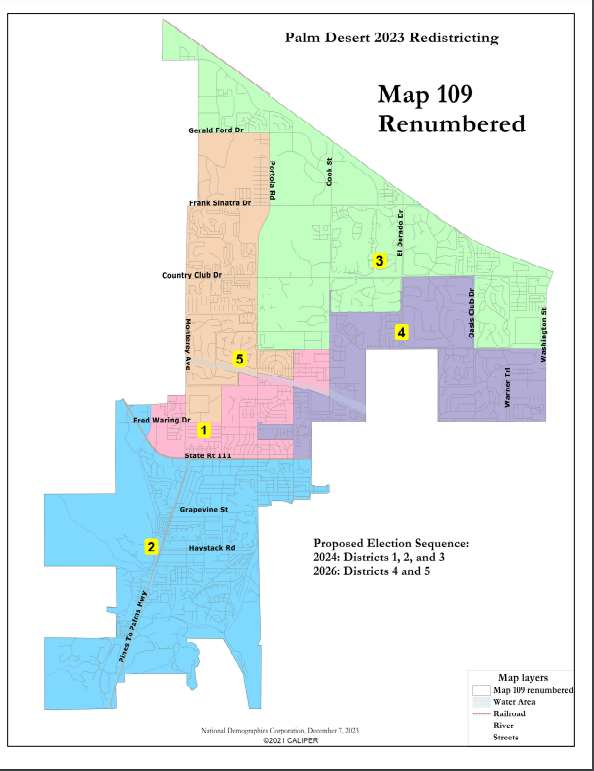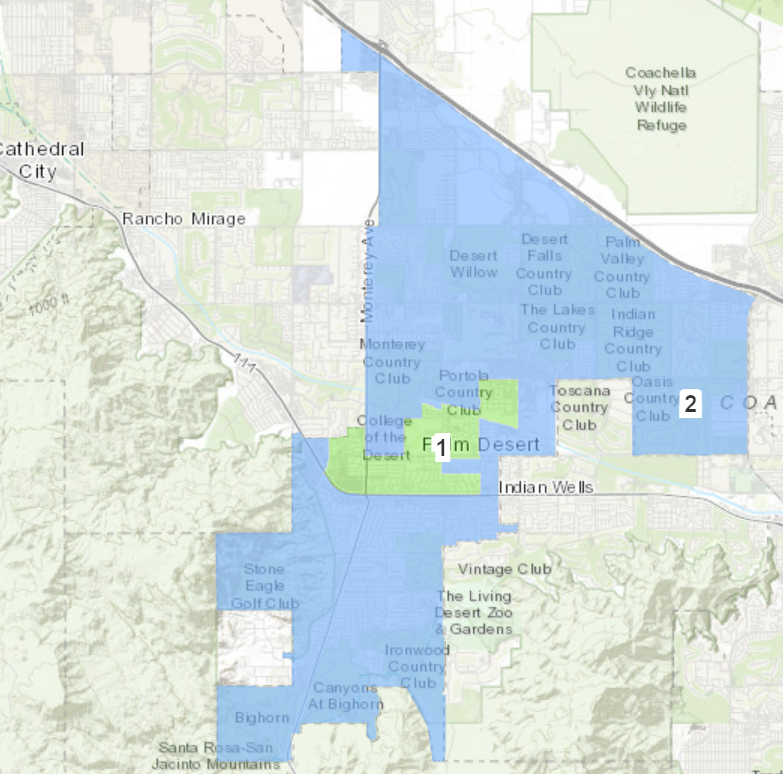Palm Desert council OKs final redistricting map for transition from two to five districts

The Palm Desert City Council gave its unanimous support Thursday to a final map through which the city will move from two to five voting districts, just over a year after a majority of voters supported the transition in an advisory vote.
The five-district map approved by the council Thursday will be in place for this year’s November election. The vote came after several recent public hearings and workshops as part of the city’s redistricting process.
The switch from two to five council districts was first approved by the council in June, after roughly 53% of the city’s voters backed the move on an advisory ballot measure in the 2022 general election.
Under the city’s current setup, residents of District 2 — which includes about 80% of the city’s population — vote for four councilmembers, while the smaller District 1 — which covers the Civic Center area and surrounding neighborhoods — has one representative.
Known as Map 109, the option backed by the council divvies up District 2 into four separate districts, while District 1 — which was the product of a voting rights lawsuit filed in 2019 — will remain intact.
With its final approval Thursday, the council will adopt an ordinance formally enacting the new districts — and introduce an ordinance eliminating ranked-choice voting as part of the transition — during its Jan. 25 meeting.
From two to five districts: How we got here
Palm Desert had at-large voting for its five council seats until 2019, when two residents filed a lawsuit against the city saying it was in violation of the California Voting Rights Act, which requires cities to ensure minority voting groups have a fair chance for representation.
That lawsuit led to the two-district setup. While Latino residents make up just over a quarter of its population, Palm Desert didn't have its first Latina council member until Mayor Karina Quintanilla — one of the suit's plaintiffs — won election in District 1 after it was created in 2020.

Roughly 44% of the voting-age population in District 1 is Latino, and city officials say any reductions in that percentage could risk a legal challenge, meaning the council was largely focused on drawing four other districts around that one.
With its move away from at-large voting, Palm Desert has joined four other cities in the Coachella Valley — Cathedral City, Desert Hot Springs, Indio and Palm Springs — that have already switched to district council systems.
What are the map's district boundaries?
The city accepted publicly submitted maps for several weeks this fall, and city officials have worked with National Demographics Corporation to develop other options and adjust maps from the public that didn’t properly balance the city’s population across the five districts.
The map advanced by the council, which was submitted by the demographer, will divide the city into the following districts:
District 1 will remain the same, covering Civic Center Park and some surrounding areas along Fred Waring Drive and north of Highway 111.
District 2 will cover all of the city south of Highway 111, as well as a small area on the west end of Highway 111 on the opposite side of the road.
District 3 will have all of Interstate 10 as its northern border, extending east to the Woodhaven Country Club. It would also include the Spanish Walk community, the Desert Willow Golf Resort and the areas surrounding the city’s campuses affiliated with California State University-San Bernardino and University of California-Riverside.
District 4 will largely go around the city limits of Indian Wells, extending east to Washington Street. It would include all of the Palm Desert Country Club, The Oasis Country Club and Indian Ridge Country Club, as well as the Hidden Palms gated community.
District 5 will largely be between Portola Road and Monterey Avenue, running south of Gerald Ford Drive down to College of the Desert. It would include Monterey Country Club, Chaparral Country Club, Suncrest Country Club and The Regent Palm Desert.
As outlined in the map, the council election for Districts 1, 2 and 3 would be held in 2024, while the election for Districts 4 and 5 would be in 2026.
Under the final map, the five current councilmembers live in the following districts, according to city spokesperson Thomas Soule:
District 1: Karina Quintanilla (term ending December 2024)
District 2: Kathleen Kelly (term ending December 2024) and Jan Harnik (term ending December 2026)
District 3: Gina Nestande (term ending December 2024)
District 4: Evan Trubee (term ending December 2026)
District 5: None.
A city staff report notes the council should consider whether any area has a history ofunderrepresentation and a relatively low voter turnout. Soule said that at its Dec. 14 meeting, the council “heard no arguments that Districts 4 or 5 had a history of being under-represented and had relatively low turnout and therefore should be prioritized for a Presidential Election cycle.”
The report also notes it’s “standard practice to match the district election years to the year of the resident officeholder.” Soule said the sequence of elections “was designed so that each resident officeholder would have an opportunity to seek re-election upon the expiration of their term, except for Jan Harnik.”
“This exception is a result of two Councilmembers (Harnik and Kelly) being paired within a single district and having opposite term cycles,” Soule said.
What the public said
The council heard from just a couple residents during Thursday’s hearing, both of whom echoed past criticisms from some residents of the city’s north end.
Michael Stafford, a resident of the area, told the council he was disappointed in the lack of support for a different map that would’ve created a single district covering the city’s northern end, from Interstate 10 south to Country Club Drive, except for a small area east of Tamarisk Row Drive.
That option submitted by Gregg Akkerman, who ran for a council seat last year, was rejected by the council in November due to its splitting of a gated community into two districts. Multiple members said was a clear "community of interest," which all be kept in the same district.
In the weeks following the council’s mid-November meeting, Stephen Nelson, a resident of the city’s north end, found that map could avoid dividing any HOAs or gated neighborhoods by swapping the Hidden Palms community into another district for a few other properties along Country Club Drive.
Stafford noted residents highlighted several shared issues for those in the northern region during those meetings and workshops.
“In summary, I don’t think it was a transparent process, and I think it’s somewhat disingenuous to ask comments of the public,” Stafford said. “We've went to a lot of those public outreach meetings. You didn't consider any of those comments, and I'm very disappointed with that.”
Another resident, Debbie Green, offered a similar perspective, noting all of the city north of Frank Sinatra Drive falls into the Palm Springs Unified School District and saying more consideration should’ve been given to that community of interest.
What the council said
Before their vote, a few councilmembers noted some shared interests in the proposed districts that hadn’t been discussed in past redistricting hearings. Councilmember Kathleen Kelly noted District 4 has a lengthy stretch of Fred Waring Drive, which she described as a major thoroughfare for commuters that has some shared traffic calming initiatives. Mayor Pro Tem Jan Harnik agreed, while noting District 4 wraps around the boundaries of Indian Wells.
Quintanilla, who opposed the council’s decision to advance a single map in November, said there was a lot of engagement throughout the redistricting process, adding that’s “the true definition of democracy.”
“The definition is not one person gets their way,” Quintanilla said. “The definition is we hear from people, and we take action.”
“Do I feel that there was equal amounts of attention given to the voices that were engaged over the setup of public hearings? I don't believe that is the case,” she added.
Quintanilla said the city should consider a dedicated traffic study that looks at speeding effects “not just within one district, but all of them.”
The council’s unanimous vote for the new maps will be followed by a formal adoption during its Jan. 25 meeting. An ordinance will also be introduced then to get rid of ranked-choice voting, which the city implemented in 2022, but the council decided to eliminate in June.
Tom Coulter covers the cities of Palm Desert, La Quinta, Rancho Mirage and Indian Wells. Reach him at thomas.coulter@desertsun.com.
This article originally appeared on Palm Springs Desert Sun: Palm Desert council OKs final redistricting map with five districts

